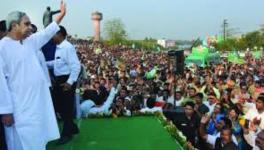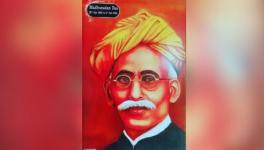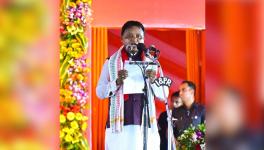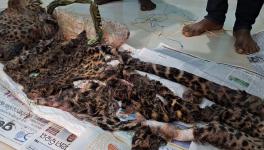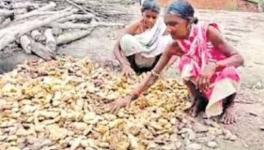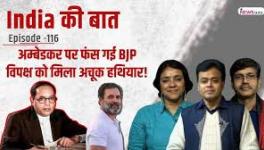Odisha: The Harsh World of Soft Cotton in Kujasingh Village
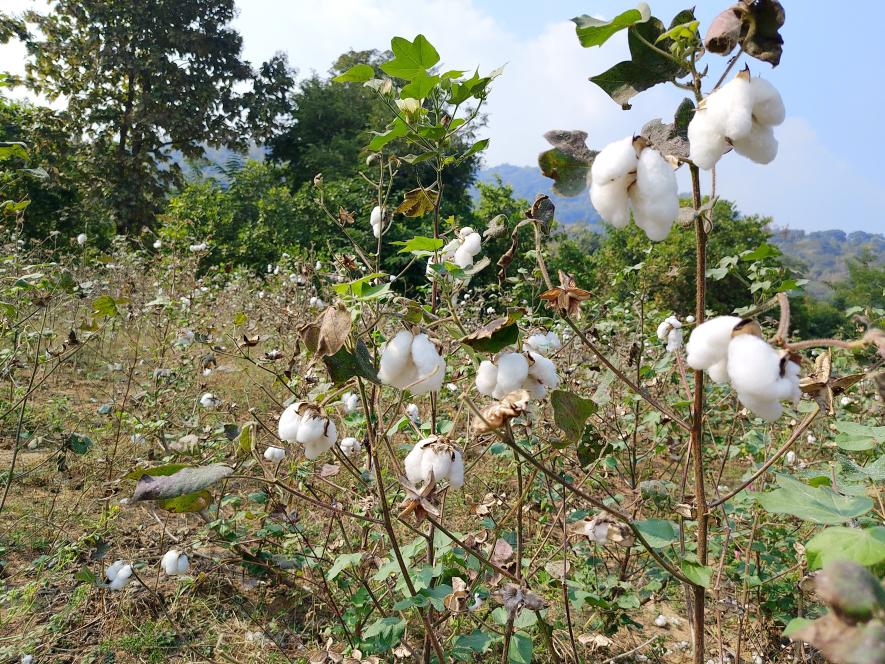
Kujasingh is a village of backward tribals in coastal Gajapati district of Odisha. As part of work, one needed to check the library in the village school. It was a dilapidated building, consisting of eight rooms. In one room, there were 19 children, aged 10-12 years, sitting on the ground in an almost half-naked state. This writer tried talking to the children in Hindi but got back blank stares as they were not able to understand anything. They understood a bit of Oriya, but not Hindi. Still, when asked: “Do you people get books?”, the children shook their heads in unison.
The faces of many of those children bore some marks. When asked, their teacher (Jayanti), who was standing nearby, mumbled in a low voice, “Cotton is cultivated here. Adults have to bend down to pluck cotton, so it takes them a lot of time. It is also a bit of boring work. So, farmers deploy small children to do this work, as they are short and don’t have to bend down to pluck a lot of cotton. They get these marks on their faces while plucking cotton”.
Jayanti’s statement sounded illogical. Cotton is grown in other parts of the country and one had not heard of such a thing till date.
When prodded further, Jayanti, said, “We are adivasis, should we look at our face or our stomachs? Actually, this is not a cotton land; we don’t even know how to grow cotton. The people of Andhra have ruined us by luring us with money”.
The teacher's words sounded puzzling. This writer left the classroom with a heavy heart, recalling how in childhood, cotton was known as “white gold”.
While descending the stairs of that dilapidated school, one could see cotton wool floating around in the air. It was a thrilling sight.
‘Thighs Without Veins’
This is the living story of people sowing cotton seeds on a mountain. Gajapati is a tribal district, which was carved out of Ganjam district in 1992. The headquarters of this coastal district is at Paralakhemundi, on the Andhra Pradesh border. It used to be the parliamentary constituency of former Prime Minister Narasimha Rao in the 1996 Lok Sabha elections.
In Mahendragiri mountain in the district, there is a belief, as per the Mahabharata, that the Pandava brothers lived on this mountain during their exile. A river named Mahendratanaya flows from the chest of this mountain. This river marks the border of Odisha and Andhra Pradesh.
Kujasingh village, located in Gumma block of Gajapati district, has 40 houses, located in the lap of a mountain. The Joraswar tribal community lives in this village. There is forest above and fields below. The main food consumed by the villagers is water and rice. And along with it, there is hand-made liquor. The village also has a pet python, which villagers said keeps lying on the road.
There are many hilly villages in these areas of Odisha where cotton is cultivated. Kujasingh is one of them. If one looks down the slope from Kujasingh, it looks like a land covered with white flowers. Seeing those cotton fields for the first time, one was reminded of a line from Kedarnath Singh's poem:
Yah jo aapki kamiz hai
Kisi ke kheton mein khila kapas ka phool hai
(This shirt of yours is a cotton flower blooming in someone's field)
Recently, while conducting a survey for a government scheme, one visited this village. It was raining heavily that day. At the panchayat office, one by one, old women started coming. Almost all of them were limping. When asked, the medical officer sitting there said,
“Cotton is cultivated here. When the cotton is plucked, before selling it in bulk, the old women keep a few sacks for themselves. Throughout the year, they rub it on their thighs with their hands to make wicks for lamps used for worship. These are sold in abundance in the temples of Andhra Pradesh. These women have been doing this work for 20–25 years. Due to this, the veins of their thighs are damaged.”
These women get Rs. 4 for making a packet of wicks, which is sold in the market for Rs.12-15, and in some places even for Rs.20. Although younger women have stopped doing this work, the older women continue doing it for survival.
This was the second imprint of “white gold” that one saw on the bodies of people of the area.
The Cotton Trap
Cotton entered like an 'angel' in some districts of south-western Odisha. In these districts -- Kalahandi, Rayagada, Gajapati, and some hilly areas of Koraput -- farmers planted cotton crops for the first time in the 1990s, leaving aside their traditional hill farming.
When asked where and how cotton first entered these areas, many villagers said they did not know how cotton reached them. One person said his father used to do cotton farming, so they also started doing it. An old farmer (Devvrat) sounded most convincing. A retired teacher, he also used to do farming. “It (cotton) came to us from Andhra Pradesh around 1990; there were many cloth factories in Andhra where cotton was needed. Gajapati is very close to Andhra, so its cultivation started here first,” said Devvrat.
After pausing for a while, he added, “Doing such farming destroys the land, and don't even ask about the diseases. The people of Andhra were clever; they ruined us by luring us with money”.
Things became a bit clearer now. Cotton has become a bone stuck in the throats for the people here. They are neither able to swallow it nor spit it out.
On a terraced cotton field, surrounded by mountains from all sides, one could see the crop being picked. A large number of children were seen working. This field belonged to Raghu, 46, the sarpanch of this tribal village.
When this writer asked Raghu (who as plucking the plants) in Hindi to explain how cotton farming was done, jokingly adding that it looked like a promising venture, he said, “Don't do cotton farming. The land gets spoiled”.
The school teacher (Jayanti), who was standing nearby, told Raghu in Oriya that we had come to learn about cotton and he should tell us whatever he knew. After remain silent for a while, he said, "The kappa (cotton) crop came to us; before that, we used to cultivate mandia (millet), arhar (pulses), and rice. In the beginning, Bt (a type of GM (genetically modified) cotton) seeds were very rare. When someone used to go to Andhra Pradesh, he used to bring it. Later, it turned into a seed business. When I did cotton farming for the first time, I made a lot of profit. It did not require as much hard work as rice. But now everyone has started growing it here. Now there is no benefit. On the contrary, our debts are increasing one after the other.”
On being asked why they don’t stop cultivating it if there is no profit, Raghu tearfully said, “Now nothing will grow on this land except cotton”.
“When we planted cotton, we did not know that it would make the field favourable only to itself. Traders from outside used to give us seeds and fertilisers. Last year, I planted pigeon pea, but it remained in the ground. This time, we have planted only cotton,” he explained.
Raghu would have told us some more things, but by then his daughter had brought food for him. He sat down have his food at the edge of the field.
As we walk away, Jayanti asked, “Bhaina (brother in Oriya), why do you want to know about cotton? Will the government run any schemes?”
With no proper answer, I asked, “Who buys this cotton?” “My uncle buys the cotton of the whole village,” I was told. I said, I want to meet him. At first Jayanti hesitated, then said “We will meet him on Sunday.”
Labour brokerage
On Sunday, we reached Jayanti's uncle's house, a big and beautiful house with various types of wooden dynasty frames, a statue of Gandhiji, and a statue of Lord Jagannath. It didn't feel like being in a tribal area. There were more than 50 cotton sacks lying in the verandah, while other sacks were being loaded on a small truck. Jayanti's uncle Loknath was counting the sacks.
After a while, he came in an attire like that of people from Andhra. In this part of Odisha, which adjoins Andhra, most of the affluent people are more influenced by the lifestyle of the people of Andhra Pradesh and want to live like them.
When told that I wanted to know and understand about cotton and why many villagers were troubled by it, Loknath began by abusing cotton-cultivating farmers in Oriya. Then he said, “Who had a house in this area earlier, whose children used to wear clothes? Everything that is visible here is because of kappa. Now, we will have to pay the price.”
When asked where the seeds of cotton were coming from, he said,
“Don’t ask; the whole problem is about the seed; this Bt (cotton variety) has been banned by Andhra people. Cotton cannot be grown there, but there is a high demand for cotton there. So, they give the seed, and cotton is grown in the border area.”
Incidentally, Andhra Pradesh has not banned Bt cotton – it has just prohibited cultivation of some types.
When asked who brought in the seeds from Andhra Pradesh went silent for a while. Jayanti piped up, “Actually, uncle brings the seed from there; he provides the fertiliser. And when the crop comes, all the farmers give the crop to uncle”.
When are the crops planted? Seed sowing starts in May-June, and the crop starts coming out in November. Do you use any manure or fertiliser? The farmers were saying the seeds are expensive and the chemicals are even more expensive.
After all these questions were fired at him, Loknath got up and said, “What expensive? Glycophosate is a little expensive. There is a ruckus over it. Doctors are saying that due to its spraying, cotton farmers are getting cancer, kidney failure. Everybody wants to starve the tribals by spreading rumors here”.
Glycophosate or glyphosate is the herbicide to which Bt cotton is tolerant. So, if you plant Bt cotton you can spray glyphosate freely without fear of the cotton plants getting damaged.
“This time, I have bought it for Rs.6,200; last time, it was Rs.5,600 per quintal,” he said.
When asked why he himself doesn’t plant cotton, Loknath said, “Who wants to die, brother?”
A medical officer, requesting anonymity, admitted glyphosate was a problem. It is sprayed before sowing seeds to kill weeds.
“But it is the root cause of cancer, and if it enters the body by mistake, then kidney damage is certain. Patients are coming to the hospital every day. The government has banned it. But people don't listen. Dealers secretly bring it from Andhra and sell it”, he said,
An officer in the agriculture department said cotton had “made the weather and climate here worse; the temperature in summers reaches 42 degrees and it is raining.”
“Now you will see that after a few days there will be no cotton. Kappa cannot withstand the onslaught of weather; the change in weather here is not favourable for cotton. The government is working, but there is no improvement visible anywhere”, he added.
So, this is the story of that white-looking flower, which has the scratched the faces of children, left thighs of old women damaged, and several bodies struggling with cancer. The souls of these illiterate tribals are wounded, all because they were lured with a few rupees and decided to turn away from traditional farming to commercial farming. Allowing themselves to be exploited continuously.
It is said that many people are involved in this “conspiracy”, and to some extent, even some among these tribals.
So, allow this writer to change poet Kedarnath Singh’s lines:
Yah jo aapke diye ki bati hai
Kitno ke jangh ki nas kha jati hai
(This wick of your lamp
It eats away the veins of so many people's thighs)
The writer studied at Banaras Hindu University, Uttar Pradesh. He is currently working as a fellow in Koraput, Odisha. The views are personal.
Get the latest reports & analysis with people's perspective on Protests, movements & deep analytical videos, discussions of the current affairs in your Telegram app. Subscribe to NewsClick's Telegram channel & get Real-Time updates on stories, as they get published on our website.











